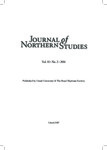Discrimination amongst Arctic Indigenous Sámi and non-Sámi Populations in Norway
| dc.contributor.author | Hansen, KL | |
| dc.contributor.author | Minton, Stephen | |
| dc.contributor.author | Friborg, O | |
| dc.contributor.author | Sørlie, T | |
| dc.date.accessioned | 2020-05-13T14:09:52Z | |
| dc.date.available | 2020-05-13T14:09:52Z | |
| dc.date.issued | 2016-07 | |
| dc.identifier.issn | 1654-5915 | |
| dc.identifier.uri | http://hdl.handle.net/10026.1/15677 | |
| dc.description.abstract |
Background: Recent research demonstrates that for many indigenous Sami people, experiencing ethnic discrimination is a regular occurrence. The present study was designed to provide estimates of the prevalence of self-reported discrimination in order to identify specific settings where discrimination happened, to identify perpetrators and to examine individuals’ responses to the discrimination. Methods: In 2012, all inhabitants aged between 18 and 69 living in selected municipalities with both Sami and non-Sami settlements in mid- and northern Norway were mailed an invitation to participate in a questionnaire survey covering questions about discrimination (types of discrimination, settings where discrimination happened, and who the perpetrator was). Altogether, 11,600 participated (a response rate of 27 %). Results: In total, 2,496 (21.5 % of the sample) reported discrimination; of these, 29.8 % reported that discrimination happened during the past two years. Ethnic affiliation, age, education level, income and living area were all significantly associated with differences in the frequency of experiencing discrimination. Respondents with a strong Sami affiliation reported the highest levels of discrimination; in total, 50.8 % responded that they had been discriminated against, compared with 14.3 % of the non-Sami respondents (OR=6.16 CI:5.42–7.00). Sami with strong Sami affiliation reported having experienced significantly more discrimination over the past two years more than did the non-Sami respondents (16.5 % vs 4.4 % respectively; p < 0.001; OR=4.15 CI:3.45–4.99). Additionally, Sami respondents reported experiencing discrimination in multiple settings more often than did nonSami respondents (p < 0.001). Respondents aged between 30 and 49 years, those with a medium high level of education, those with medium household income, and those living in Sami minority areas, reported the highest prevalences of discrimination. In terms of responses to discrimination, 37.6 % reported that they had done something to stop the discrimination, and 19.1 % reported that the discrimination had affected them a lot. Just 1.8 % of those who reported having been discriminated against had been in contact with the Equality and Anti-Discrimination Ombudsman Service in Norway. Conclusion: The findings from this study show that the Sami people still experience high levels of discrimination in Norwegian society. Our findings suggest that interventions specifically designed to prevent discrimination against the indigenous Sami people of Norway should be implemented. | |
| dc.format.extent | 45-84 | |
| dc.language.iso | en | |
| dc.title | Discrimination amongst Arctic Indigenous Sámi and non-Sámi Populations in Norway | |
| dc.type | journal-article | |
| plymouth.issue | 2 | |
| plymouth.volume | 10 | |
| plymouth.journal | Journal of Northern Studies | |
| plymouth.organisational-group | /Plymouth | |
| plymouth.organisational-group | /Plymouth/Faculty of Health | |
| plymouth.organisational-group | /Plymouth/REF 2021 Researchers by UoA | |
| plymouth.organisational-group | /Plymouth/REF 2021 Researchers by UoA/UoA04 Psychology, Psychiatry and Neuroscience | |
| plymouth.organisational-group | /Plymouth/Users by role | |
| plymouth.organisational-group | /Plymouth/Users by role/Academics | |
| dcterms.dateAccepted | 2016-06-30 | |
| dc.identifier.eissn | 1654-5915 | |
| dc.rights.embargoperiod | Not known | |
| rioxxterms.licenseref.uri | http://www.rioxx.net/licenses/all-rights-reserved | |
| rioxxterms.licenseref.startdate | 2016-07 | |
| rioxxterms.type | Journal Article/Review |


